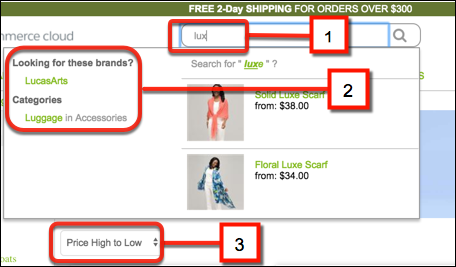Learn About B2C Commerce Search
Learning Objectives
After completing this unit, you’ll be able to:
- Describe how you can increase search hits from external search engines.
- Give an example of how search redirects benefit shoppers.
- List what you can include in a search index.
- Describe how the search index is updated.
- Explain the difference between merchant-directed and shopper-directed search sorting.
- Explain what Einstein search dictionaries can do.
Introduction
Online shoppers want to find stuff fast! Salesforce B2C Commerce comes with lots of search capabilities to help your shoppers find the things they’re looking for. In this unit, we cover search redirects, the search index, searchable attributes, and search configuration settings in Business Manager. We also look at the B2C Commerce search engine optimization (SEO) capabilities, for when the search comes from a search engine like Google.
Search Features
Type-Ahead Search
B2C Commerce starts processing a storefront search as soon as shoppers type a few characters into the search field. As they type, B2C Commerce is already checking for things like spelling and word completion. It also gives suggestions, such as a category.

The shopper enters “lux” (1) into the keyword search field. Search suggestions (2) display after the third character. The shopper can also select how they want their search results to sort (3).
Search Redirects
After the shopper enters a search term, B2C Commerce can process a search redirect. In a search redirect, a predefined term, like wedding dress, sends the shopper to a specific page or URL instead of to a search results page. The Wedding Dress page (or site) might have a unique look and feel, special content, access to a bridal registry, wedding guide information, and pricing. By going directly to the site, the shopper’s enhanced buying experience increases the likelihood that they buy something.
Search Index
B2C Commerce passes the information that the shopper types to the search index. The search index is a collection of data about the site’s products and content that shoppers can search for. And this is key! Data isn’t searchable by default. You have to configure product and content data as searchable in Business Manager.
You configure product details and attributes—data such as brand, ID, name, and description—as searchable. For example, when you include product names and descriptions in your search index, and a shopper enters beaded wedding dress in the search field, the search results page displays any product names and descriptions that include the phrase beaded wedding dress, or any combination of the three words, depending on your configuration.

Don’t go overboard when you mark data as searchable. The more data you configure as searchable, the bigger the index, and the slower the search speed.
The B2C Commerce search index combines several indexes that handle spelling, content, synonyms, suggestions, and product availability. In Business Manager, you can define all kinds of information.
-
Synonyms: Terms that mean the same thing.
-
Hypernyms: Term for a group of products. For example, the term top is a hypernym that contains the hyponyms tunic, shirt, and blouse. When a shopper searches for top, B2C Commerce returns products that contain top, tunic, shirt, and blouse.
-
Hyponyms: Term for an item in the group of products that a hypernym describes. For example, blouse is a hyponym of the hypernym top. When the shopper searches for blouse, B2C Commerce only returns products that contain blouse.
Let’s look at an example of synonyms. Suppose you configure a synonym list for the terms bag, purse,pocketbook, and tote. When shoppers search for bag, B2C Commerce looks for bag OR purse OR pocketbook OR tote, and returns:
-
bag and bags
-
purse and purses
-
pocketbook and pocketbooks
-
tote and totes

The search index derives search terms from these types of product data.
-
Stop words: Define words that the search engine ignores, such as an or the.
-
Compound words: Define words that the search engine splits into separate terms. For example, if you configure foot-* as a compound word, a search for footstool returns results for foot and stool.
-
Common phrases: Define word combinations that the search engine finds as a unit, such as pencil case .
-
Word stems: Define the common root of one or more words. For example, boot is the stem of boots and booties .
-
Special characters: Configure the search engine to remove these special characters: ! ( ) : [ ] { } + ~ ^ ? ' .
-
Product numbers: Configure the search engine to split product IDs into their parts. For example, a product ID shirt-1234 can be split into shirt and 1234 .
-
Short terms: Specify short words (fewer than three characters) that the search engine evaluates. Search suggestions and the Did You Mean features ignore short terms unless you specify them.
You want site data that's as fresh as possible, but rebuilding the index after every update isn't always practical. Indexing everything can take hours, depending on the amount of data and the complexity of the search configuration.
There are other ways, however, to keep the search index up to date. Turn on Incremental Indexing to update the index whenever someone changes search configurations or product details in Business Manager.
Einstein Search Dictionaries
Einstein Search Dictionaries uses artificial intelligence to make your site search even smarter, by collecting data from all site searches and settings to find search terms that aren’t in your dictionaries. Then, it detects relationships between search terms and recommends which synonym lists to assign terms to.
Search Preference Settings
Business Manager search preferences gives you tons of control over storefront search. Use preferences to hide products that aren’t available or move those with limited availability to the bottom of the search results.
SEO
If you can get the attention of external search engines like Google, you can drive sales. Optimize your site for search engines with a few basic settings in Business Manager.
-
Get more search engine attention: Streamline URLs and eliminate irrelevant keywords, multiple directory layers, and parameters. Dynamically create HTML page metatags and heading tags, embedded information to get hits.
-
Focus attention on the sites to be searched: Configure robot.txt files, which web crawlers and other web robots check to see if site indexing is allowed.
-
Don’t miss a sale: Configure hostname aliases for alternate URL names.
-
Retain loyal shoppers: Send shoppers from an old URL to a new one via URL redirects.
-
Populate search engine indexes: Configure sitemaps with website contents for crawler consumption and indexing. Sitemaps are XML files that provide search engines with information like a list of available URLs, when a page was last updated, frequency of updates, and page relevance. Search engines use this information to construct links to the site and control the ranking of links within search results.
-
Avoid dead-ends: Configure alternative paths to avoid 404s, or file not found errors.
-
Preserve search rankings for pages that seem like duplicates: Configure within your page headers which of multiple similar URLs is the preferred or canonical one.
After the Search
After the search results display, shoppers sometimes need more guidance. For example, you can help them sort or refine their results. Sort results to highlight top sellers or showcase your latest products. You can also let shoppers customize search results by sales, product availability, or personalized details.
Sorting the Search Results
You can use Business Manager to configure B2C Commerce sorting rules to change the order of search results, or to let your shoppers change the order themselves. Shoppers direct their own sorting through storefront sorting options. The options appear in a dropdown list on a search results page. Shoppers click an option, such as Low to High to sort by price.
You control the search results behind the scenes with merchant-directed sorting. For example, you can show new merchandise at the top. These are the ways you can sort search results.
-
Default sorting for keyword searches: The shopper enters text into the search field and products that most closely match the search terms display at the top.
-
Category sorting: Products display based on site category navigation. Categories that are assigned to more than one site can have a different default sorting rule for each site.
-
Dynamic attributes: Products display based on attributes that are always changing, such as profit margin and availability.

The shopper searched on dressy shoes to get this search result.
Refining the Search Results
Shoppers can refine search results. For example, they can search for shirts, and then refine the search by brand, size, and finally color. This is really useful when there are lots of products to sift through.
Resources
- Salesforce Site: Salesforce B2C Commerce
- Trailhead: Sell Everywhere With Commerce Cloud
- Salesforce Help: Search and Navigation
- Salesforce Help: Search Engine Optimization